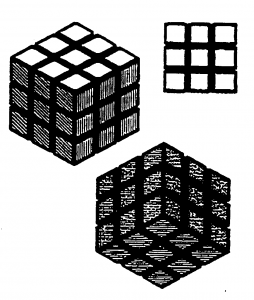News
The Final Twist: Rubik’s Cube Trade Mark Declared Invalid by EU Court
1 December 2016
On 10 November 2016, the Court of Justice of the European Union (CJEU) decided that the famous Rubik’s Cube could not be a registered trade mark. This marks the end of a ten year tussle over the registrability of one of the world’s best-selling toys of all time.
The trade mark in question is Seven Towns Ltd’s 3D trade mark (depicted below) for “three dimensional puzzles”.
This was registered as an EU trade mark from 1 April 1996.
In 2006, a German toy manufacturer, Simba Toys GmbH & Co. KG, applied to invalidate Seven Towns’ registration on the basis that the trade mark is a shape which is “necessary to obtain a technical result”, i.e. that the internal rotating capability of the cube is a functional element that should not be protected by trade mark law.
Decision
The underlying rationale in assessing 3D shape trade marks is that registered trade marks should not grant a permanent monopoly for technical solutions. That is the preserve of patents.
The CJEU considered the decision of the General Court (GC), which had upheld the validity of the Rubik’s Cube mark. The GC had taken the view that inferring the existence of an internal rotating mechanism from the graphic representations of that mark would not have been appropriate, particularly due to a lack of sufficient certainty. In other words, the graphic representation of the trade mark did not provide a direct indication that the cube was capable of rotation due to its internal constituent parts.
With this in mind, the CJEU affirmed that “the essential characteristics of a shape must be assessed in the light of the technical function of the actual goods concerned”. Unlike the GC’s consideration that the assessment must be made objectively, the CJEU directed the assessment to the actual goods at issue. For the Rubik’s Cube shape mark, this meant examining the rotational capabilities of the puzzle by virtue of its interior mechanics.
For this reason, the non-visible elements of the graphic representation of the 3D shape mark had to be considered. As they had a technical function, the trade mark was declared to be invalid.
Importance for Brand Owners
This decision highlights the interplay between patent and trade mark law. For functional elements, such as the rotational capabilities of the Rubik’s Cube, obtaining trade mark registration is not appropriate. In this instance, obtaining a patent is the means of protecting technical aspects of a product. The eternal monopoly granted by a trade mark registration is not appropriate for technical solutions. If it were, this would be at odds with the public policy of allowing technical solutions to become freely available to the public after the expiry of any patent rights.
The invalidation of the Rubik’s Cube EU trade mark registration could lead to competition from imitations. It will also act as a prompt for owners of 3D shape mark to review their trade mark portfolio to ensure that their registrations are not vulnerable to invalidation due to their underlying functionality.
Mark Caddle
Trade Mark group
If you require further information on anything covered in this briefing, please contact Mark Caddle (mcaddle@withersrogers.com; +44 207 940 3600) or your usual contact at the firm. This publication is a general summary of the law. It should not replace legal advice tailored to your specific circumstances.
© Withers & Rogers LLP, December 2016





